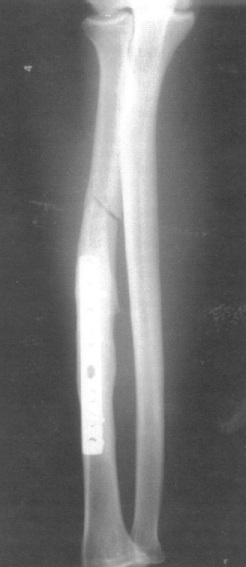With the ink barely dry on the extensive coverage of Robert Griffin III’s unfortunate injury, Rob Gronkowski’s re-fractured forearm prompted fans to again ask, “Did he return too soon?” this week.
Shortly after the injury, there were two competing conversations on Twitter. Some wondered if it was possible for a bone to break after it was surgically fixed with a plate and screws. (The answer is yes. Bone and/or hardware can fail in a bone that has been surgically fixed.) Others were convinced that the New England medical staff allowed Gronkowski to return to play before the bone had fully healed, speculating that the bone broke in the same spot as the original injury.
While the second argument is reasonable, there are multiple instances of NFL players returning to play within six weeks of a surgically repaired forearm fracture without complications. Though it takes longer than six weeks for bone to fully heal after a fracture, it’s likely that follow up tests showed that Gronkowski’s fractured bone(s) had healed enough to minimize the risk of a return to play.
Further, CSNNE’s Tom Curran reported today that Gronkowski’s bone broke in a different spot, specifically “at the end of the protective plate that was implanted in his arm.” Curran’s source also said that the re-injury had “nothing to do with whether the arm was ready or not.”
I’ve been asked if that explanation is valid or another instance of the Patriots clouding the true picture of an injury to one of their players. There’s no way to answer that definitively, of course, but the explanation Curran’s source gave is reasonable.
Advances in orthopedic hardware in recent years (use of titanium, subtle changes in how rigid the plate/screw fixation is performed) are thought to decrease the risk of a fracture near the end of a plate. But those fractures are still possible. Without getting into a long discussion of bone physiology and biomechanics, bone near the end of a plate – even though it was not part of the original fracture – is weaker than usual. The bone is also stressed differently in a fall because the plate is rigid at the end.
That weakness may not affect how you or I would recover from a broken arm. But it is definitely a consideration for an NFL tight end that must use his arm to protect himself on the field. Unfortunately, there is no way to estimate the risk of this kind of fracture. It’s a theoretical risk for many months after surgery. Curran’s source said the risk was as long as three years; I have seen 18-21 months quoted in orthopedic journals.
Whatever the answer, the risk is likely small enough after 6-8 weeks that waiting until it becomes zero is not acceptable to an elite athlete. Why not remove the plate and screws after the bone heals, then? The risk of a second fracture after plate removal is thought to be even higher.
In short, it’s probably correct to consider Gronkowski’s fall, landing and re-injury nine weeks after his first surgery a perfect storm of sorts. He will have the benefit of months – rather than weeks – to recover after the second surgery. The extra time should decrease Gronkowski’s risk of a similar injury next season.
Categories: Injury Updates

 14 Players at Risk of a Medical Red Flag on Draft Day
14 Players at Risk of a Medical Red Flag on Draft Day  More Surgery Necessary For Rob Gronkowski?
More Surgery Necessary For Rob Gronkowski?  Rob Gronkowski: Three Surgeries, One Impressive Scar
Rob Gronkowski: Three Surgeries, One Impressive Scar  Star Lotulelei: Why His Pro Day Workout May Be Irrelevant
Star Lotulelei: Why His Pro Day Workout May Be Irrelevant
Leave a comment